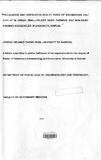| dc.description.abstract | A prevalence study of E.coli 0157:H7 was done amongst smallholder dairy
farming and neighbouring non-dairy households in Dagoretti Division of Nairobi
city, to determine the herd prevalence of E.coli 0157:H7, and to assess potential
exposure pathways to household members.
Two hundred and ninety smallholder dairy farmers and 136 neighbouring
non-dairy farmers were interviewed. Several exposure pathways were assessed:
(a) use of cattle faeces as manure (fertilizer) on farms, (b) consumption of raw
vegetable salads (c) consumption of fermented (soured) raw milk,
(d) Consumption of raw milk, (e) Household water source (f) water treatment
(g) Handling of cattle faeces without protective gloves. The households were also
interviewed on basic household characteristics such as (a) level of education for
the household head (b) household land size (c) number of years lived in the
location (d) number of members in a household. Community workshops and
gender disaggregated focus group discussions were organised within the division.
Proportional scoring was done by men and women on daily activities that are
potential exposure factors in a dairy farming household.
Cattle faecal and milk samples were used for culture and isolation of E.coli
0157: H7. Colonies of E.coli were isolated using standard microbiological
methods. E.coli positive isolates were serotyped with 0157 antiserum and
polymerase chain reaction done to detect genes coding for Verotoxin production.
Hired male worker spends over 50% of his daily time doing dairy related
activities. Seventy three percent of the dairy farming households were using cattle
faeces as manure on vegetable farms, 85% were not using protective gloves while
handling manure. Fifty three percent were consuming raw vegetable salads not
washed in clean water. Twenty one percent were consuming fermented raw milk
and 4% of both the dairy farming and non-dairy farming households were not
boiling the milk and were therefore at risk of infection.
Ninety six percent of both dairy and non-dairy households mitigated the risk
of infection by boiling the raw milk before consumption, while household
drinking water was boiled by 41% of the dairy farming and 47% of the non-dairy
households. Other households also added chlorine to the drinking water (22.7% of
dairy households and 6% of the non dairy households). Most of the households
obtained water from the city council (78% dairy farming and 94.5% of non dairy
households) which was considered to be chlorinated.
Women had a lower level of education in both dairy and non-dairy households
than men with an estimated proportions of (0.32; CI 0.219-0.436) for women
having informal education compared to (0.11; CI; 0.07-0.16) for men in dairy
households and a proportion of (0.04, 0.02) for women and men, respectively, in
non-dairy households. Male headed dairy households also had a higher estimated
proportion of secondary level of education (0.30; CI; 0.24-0.36; P<O.OOOl).
There were 15 faecal E. coli 0157 sample isolates from dairy farming
households and 3 milk E. coli 0 157 sample isolates from non-dairy households
that agglutinated with the antiserum against 0157. Only one faecal E.coli 0157
isolate had genes for verotoxin 1 production. Of the 18 E.coli 0157, sample
isolates 27.7% were resistant to Sulphamethoxazole and 11.1% to Tetracycline.
The isolate that was amplified by primers of E.coli 0157:H7 on polymerase chain
reaction was however sensitive to all the antimicrobials. The apparent prevalence
of E.coli 0157 in cattle faeces and milk was determined as 5% (Cl; 3-8) and 2%
respectively. However, the apparent herd prevalence of E.coli 0157:H7 was less
than 2%.
The study concluded that the risk of infection by E.coli 0157:H7 in urban
dairy farming households was low, however, the presence of the E.coli 0157 at a
prevalence of 5% indicates a potential health hazard because the E. coli 0157 can
acquire the verotoxin producing gene by bacteriophage through conjugation.
Therefore there is a need for continued surveillance to prevent any future outbreak
in case the prevalence increases. The findings from this study and other studies on
benefits of urban agriculture can be used by the policy makers to legalise urban
dairy farming activities in Kenya. | en |

